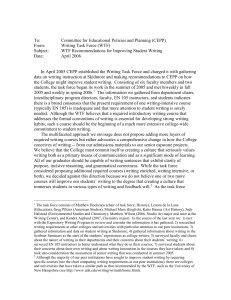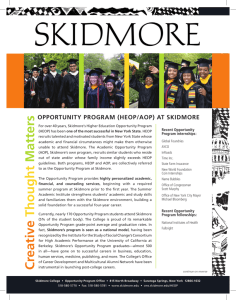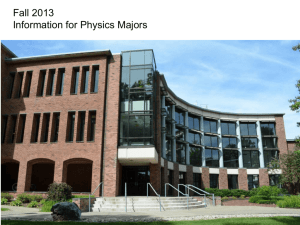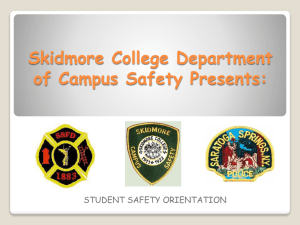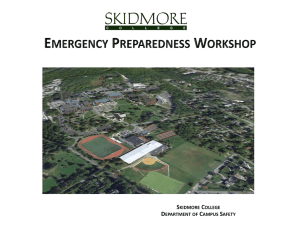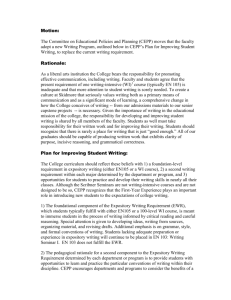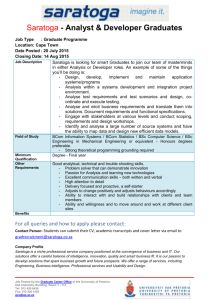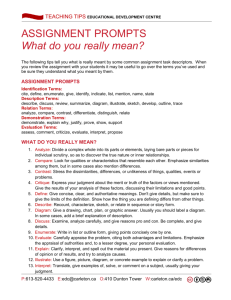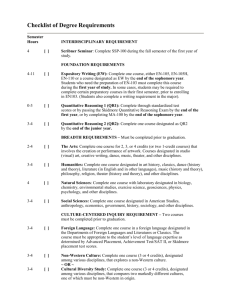Environmental Studies
advertisement
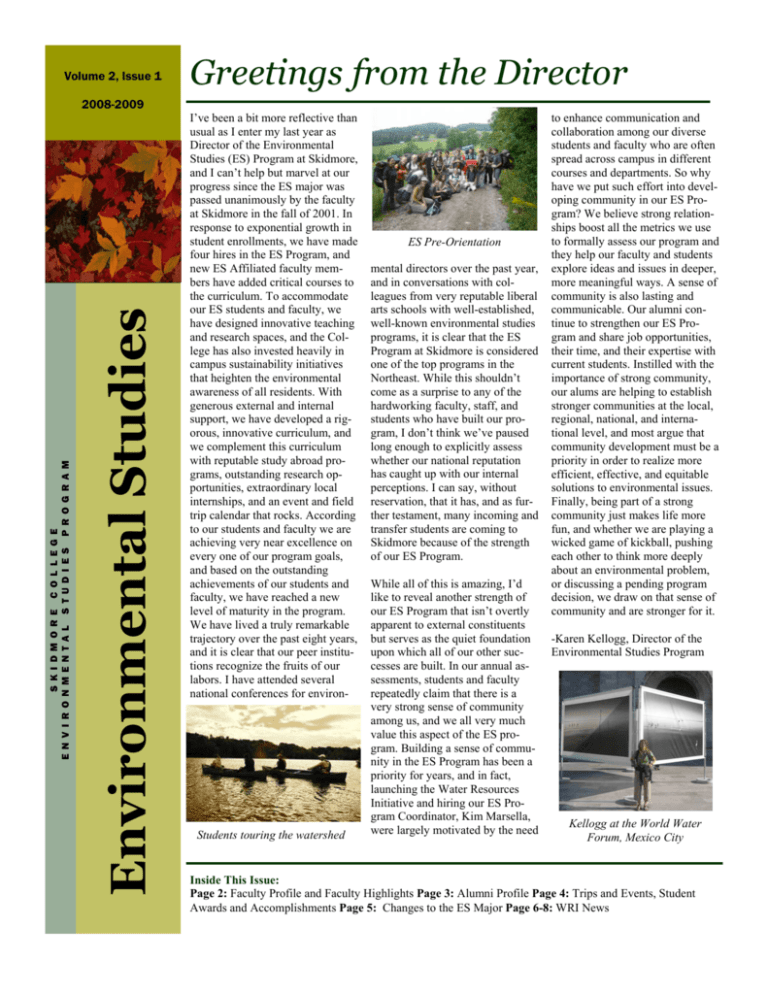
Volume 2, Issue 1 Greetings from the Director Environmental Studies S K I D M O R E C O L L E G E E N V I R O N M E N T A L S T U D I E S P R O G R A M 2008-2009 I’ve been a bit more reflective than usual as I enter my last year as Director of the Environmental Studies (ES) Program at Skidmore, and I can’t help but marvel at our progress since the ES major was passed unanimously by the faculty at Skidmore in the fall of 2001. In response to exponential growth in student enrollments, we have made four hires in the ES Program, and new ES Affiliated faculty members have added critical courses to the curriculum. To accommodate our ES students and faculty, we have designed innovative teaching and research spaces, and the College has also invested heavily in campus sustainability initiatives that heighten the environmental awareness of all residents. With generous external and internal support, we have developed a rigorous, innovative curriculum, and we complement this curriculum with reputable study abroad programs, outstanding research opportunities, extraordinary local internships, and an event and field trip calendar that rocks. According to our students and faculty we are achieving very near excellence on every one of our program goals, and based on the outstanding achievements of our students and faculty, we have reached a new level of maturity in the program. We have lived a truly remarkable trajectory over the past eight years, and it is clear that our peer institutions recognize the fruits of our labors. I have attended several national conferences for environ- Students touring the watershed ES Pre-Orientation mental directors over the past year, and in conversations with colleagues from very reputable liberal arts schools with well-established, well-known environmental studies programs, it is clear that the ES Program at Skidmore is considered one of the top programs in the Northeast. While this shouldn’t come as a surprise to any of the hardworking faculty, staff, and students who have built our program, I don’t think we’ve paused long enough to explicitly assess whether our national reputation has caught up with our internal perceptions. I can say, without reservation, that it has, and as further testament, many incoming and transfer students are coming to Skidmore because of the strength of our ES Program. While all of this is amazing, I’d like to reveal another strength of our ES Program that isn’t overtly apparent to external constituents but serves as the quiet foundation upon which all of our other successes are built. In our annual assessments, students and faculty repeatedly claim that there is a very strong sense of community among us, and we all very much value this aspect of the ES program. Building a sense of community in the ES Program has been a priority for years, and in fact, launching the Water Resources Initiative and hiring our ES Program Coordinator, Kim Marsella, were largely motivated by the need to enhance communication and collaboration among our diverse students and faculty who are often spread across campus in different courses and departments. So why have we put such effort into developing community in our ES Program? We believe strong relationships boost all the metrics we use to formally assess our program and they help our faculty and students explore ideas and issues in deeper, more meaningful ways. A sense of community is also lasting and communicable. Our alumni continue to strengthen our ES Program and share job opportunities, their time, and their expertise with current students. Instilled with the importance of strong community, our alums are helping to establish stronger communities at the local, regional, national, and international level, and most argue that community development must be a priority in order to realize more efficient, effective, and equitable solutions to environmental issues. Finally, being part of a strong community just makes life more fun, and whether we are playing a wicked game of kickball, pushing each other to think more deeply about an environmental problem, or discussing a pending program decision, we draw on that sense of community and are stronger for it. -Karen Kellogg, Director of the Environmental Studies Program Kellogg at the World Water Forum, Mexico City Inside This Issue: Page 2: Faculty Profile and Faculty Highlights Page 3: Alumni Profile Page 4: Trips and Events, Student Awards and Accomplishments Page 5: Changes to the ES Major Page 6-8: WRI News Faculty Profile: Rik Scarce Despite calling himself “someone who doesn’t like water that much,” Rik Scarce’s teaching and research interests are, well, all wet. His Ph.D. dissertation—in Sociology—was a study of the “social constructions of nature” that different groups of salmon biologists created. And the focus of his current research, as well as a Scribner Seminar he teaches, is sustainability in the Hudson River region. It seems Scarce can’t get away from water no matter how hard he tries. A member of the Skidmore faculty since 2003, Scarce explains the social construction of nature concept by saying, “It’s really all about meaning. What nature means to you—what it is to you—depends on your social background and your concerns.” And why study nature’s meanings? “Those different constructions underlie conflicts about nature,” Scarce says. “If we can identify the contours of conflicting constructions, and if we can identify the underlying basis for those constructions, we can better understand why environmental conflicts emerge and are so persistent. “From there,” Scarce says, “we can uncover things like the fundamental faults in one side’s argument or create the foundation for cooperation and compromise.” Scarce teaches two courses that are listed in the Environmental Studies curriculum, Environmental Sociology (SO 223S) and Social Theories of the Environment (SO 326). A key component in Environmental Sociology is service learning. Scarce sends his students out into the community, and across campus, to work on projects as diverse as environmental education and lupine seed gathering. “Service learning is all about creating a close bond between the classroom and the community,” Scarce says. “Students apply what they’ve learned in class, and in class they reflect on what they’ve learned during their projects. It’s an enlightening cycle, I think.” Scarce grew to love liberal education as an undergraduate at Stetson University in Florida, and he was inspired to teach by one of his Master’s Degree professors at the University of Hawaii. But he says it was a long road to get where he is today. After completing that sociologyof-salmon-biology Ph.D. at Washington State University in 1995, he first taught at Montana State and then Michigan State before coming “home” to Skidmore. He has served on the ES Steering Committee since the day he moved into his office at Skidmore. Scarce's writings are diverse. He published his first book, Eco-Warriors: Understanding the Radical Environmental Movement, in 1990 and updated it in 2005. It provided the first in-depth look at the radical environmental movement, including Earth First! and the Sea Shepherds--the latter now the topic of the television show Whale Wars. Scarce's dissertation was published as Fishy Business: Salmon, Biology and the Social Construction of Nature, and he has also written a memoir about his encounter with the criminal justice system in defense of the First Amendment and researchers' rights titled Contempt of Court: A Scholar's Battle for Free Speech from Behind Bars. In addition, he has written numerous scholarly journal articles and book chapters on a diverse array of subjects. For fun, Scarce enjoys hiking (he’s working toward becoming an Adirondack 46er) and kayaking—odd, for someone who claims not to like the wet stuff. Faculty Highlights Program Director Karen Kellogg returned in the fall of 2008 after a yearlong sabbatical and among other things taught two new exciting courses. The first, Sustainable Development and Corporate Responsibility was co-taught with Mark Youndt, Associate Professor of Management and Business, for the MALS program, and she also redeveloped ES221 Sustainable Development, an extremely popular course for our majors and minors. A highlight of the course was a videoconference with three ambassadors from the United Nations. Kellogg was also the keynote speaker at the Friends of the Kayaderosseras annual meeting, a testament to the strength of our WRI program and community outreach. Assistant Professor Cathy Gibson Page 2 developed and delivered an exciting new course titled Restoration Ecology (ES351A) and was an invited seminar speaker at Bard College on "Stream ecosystem functioning in urban landscapes". She also coauthored a paper currently in press for the Journal of the North American Benthological Society titled "Twenty-six research questions in urban stream ecology: an assessment of the state of the science". Her research was presented at international stream ecology conferences and included three ES student coauthors. Assistant Professor Josh Ness has also been busy developing a new course for the major, ES 205 Conservation and Use of Forested Ecosystems, which is Left: Cathy Gibson (orange gloves) and Hannah Phillips ‘10 deploying leaf bags for ES105 E N V I R O N M EN T A L S T UD I ES Faculty Highlights (continued) one of the important components of the new Environmental Science track of the major and will be offered for the first time this fall. Josh and the ES students have also been active outside the classroom. WRI-funded summer research collaborations focused on exotic plant invasions in the Upper Hudson watershed led to two research presentations at international conferences with three ES students highlighted as co-authors. He also gave invited research seminars at the Harvard Forest Long Term Ecological Research Station and Fordham University. Gibson and Ness were awarded a LI-COR Environmental Education Fund Grant for $40,000, which will partially fund the purchase of an innovative instrument that will help our students measure carbon storage and flux (that is, photosynthesis and respiration) within local forests. Program Coordinator & Lecturer Kim Marsella taught a section of ES100 in the fall and organized the trips and events showcased on page 4 before taking a maternity leave in the spring. Her son, Finn Neils, was born on January 19, Left: Josh Ness Opposite: Kim Marsella and Finn with students and faculty at capstone 2009 and was gracious enough to attend the capstone events highlighted on pages 6-7---while he slept through the entire program this was no reflection on the research presented! We are fortunate to have over 45 ES Affiliated Faculty from 18 different departments and programs across campus participate in the ES Program by offering environmentally-oriented courses and active research programs to students throughout the academic year and summer. Please see our faculty webpage for a complete list our ES Affiliated Faculty and look for highlights of their work in future newsletters (http://cms.skidmore.edu/ environmental_studies/faculty/index.cfm). Alumni Profile: Josh Whitney Josh Whitney ’03 graduated with honors in Environmental Studies and with a passion for promoting green building and addressing climate change using practical solutions. His career path has taken him from the non-profit sector teaching economics to environmental leaders in developing countries to consulting with Fortune 500 firms on their sustainability plans and initiatives. As a project director with WSP Environment & Energy, a global consultancy based in San Francisco, Josh spent 4 years developing expertise in corporate sustainability strategy. He has helped high-tech clients such as Microsoft and Cisco Systems to design and implement carbon-neutral initiatives including carbon footprinting at the organization and product level. A recent project entailed evaluating the carbon and business impact of distributing MS Office software through online downloads only, as opposed to selling it on DVDs. Acting on the findings, Microsoft has switched its distribution channel, boosting its carbon savings and efficiency by a factor of 8. In 2008 Josh returned to the academic setting to pursue an MBA from the Leeds School of Business at the University of Colorado, VOLUME 2, ISSUE 1 Boulder. He is focused, in his words, “at the intersection of entrepreneurship, clean technology and information technology, capital and sustainability.” He admits that’s “a mouthful,” but it has essentially poised him to help entrepreneurs and corporations develop innovative, sustainable solutions to their business issues. For example, over the summer he worked with a wide range of organizations, including the National Renewable Energy Laboratory (NREL), TechStars, and a few cleantech and Web 2.0 startups. As an intern with NREL, the nation’s primary R&D laboratory for renewable and efficient energy, Josh helped to prioritize the research and products that have the most potential impact in the marketplace. He says that “the mixing and matching of subjects is deliberate, and something that I think I really learned how to manage and appreciate while at Skidmore. My interests are diverse, and I definitely value the breadth of knowledge and experience that I’m acquiring, as opposed to being an expert in merely one discipline.” Josh challenges the idea that business and environmental sustainability don’t mix; he sees exciting opportunities in energy and clean technology that have a huge potential to improve not only the business bottom line but the triple bottom line. In his spare time Josh is an elite cyclist who races nationally in road, mountain, and cyclocross events as part of the Rocky Mounts/ Izze Beverage cycling team. He is also a passionate telemark skier, alpinist, rock climber, and “general obsessor of the mountain life.” To keep up with Josh’s sustainability work and/or outdoor adventures, visit his blog at http://www.josh-whitney.com. Josh also volunteers to counsel students and alumni through Skidmore’s Career Advisor Network. Page 3 Trips and Events For the past 6 years Kim Marsella has led incoming first year students on backpacking trips to Merck Forest as part of the ES Pre-Orientation program. For the first two years, Program Director Karen Kellogg co-led the trip but in 2004 Biology Senior Teaching Associate Sue Van Hook took over as co-leader. The program introduces the students to sustainable farming and forestry practices through two days of hands-on projects. Incoming students also get a chance to meet ES faculty and upper class students who serve as peer mentors, and enjoy their free time together swimming, hiking and sitting around the campfire. It is an amazing way to start off the school year and a great bonding experience for all involved. On September 13th 2008, Kim Marsella and Campus Sustainability Coordinator Erica Fuller organized the first annual North Woods Stewardship Day. We partnered with the City of Saratoga Springs Finance Commissioner Ken Ivins and County Supervisor Matt Veitch who recognize the importance of this green space to the Saratoga Community. Approximately 30 volunteers came out for the day to help with various improvement projects in the woods. Fuller organized a spring stewardship day that was also well-attended and we plan to continue to co-host these events each semester in order to improve and preserve our North Woods. On October 13th 2008, we reinstated our annual Environmental Studies Welcome Reception and Keynote Address with an event that highlighted sustainability. Our keynote address was from ecologist, environmentalist and author Tom Wessels who spoke on “The Myth of Progress: Toward a Sustainable Future”, and the reception that followed featured representatives from 10 different governmental and local non-profit organizations. The event was a wonderful way to kick off the school year and allowed students to mingle with the faculty and community members while learning about internship and study abroad opportunities. Our students and faculty embarked on two extracurricular trips together during the academic year. Our first trip was a group hike up Prospect Mountain in the southern Adirondacks. This was a great way to spend some time together outside of the classroom and to have some informal conversations about the natural and cultural history of the Adirondacks. Our second trip was to “The Living Machine” in New Lebanon, NY an ecological system that treats wastewater using the principles of natural systems in a setting that allowed the students to observe all of the steps involved in the process. Students were excited to see the application of concepts they had learned in ES100, ES105, ES351A Restoration Ecology and BI 240 Environmental Biology. Students and faculty at “The Living Machine” Student Awards and Accomplishments This year the ES Program implemented the Environmental Studies Faculty Awards to be awarded annually to two outstanding graduating seniors, one in each track of the Environmental Studies major, who, through academic achievement, community engagement, and leadership, demonstrate exceptional promise in addressing environmental issues. Our first recipients from the class of 2009 were Hannah Harris (Environmental Science Hannah Harris Track) and Brad Nesbitt (Social & Cultural Perspectives Track), and both students were recognized at the Honors Convocation on April 29, 2009. Hannah was cited as “elevating the discourse in courses through her creative, inquisitive, and positive presence and bringing a remarkable level of rigor and dedication to her research endeavors in Ecuador and at Skidmore. Whether it is spatially mapping monkeys in the Amazon, identifying aquatic insects to assess the impacts of land use, or coordinating the community bike program for the Environmental Action Club, Hannah brought a focused dedication Brad Nesbitt that is truly inspiring.” As a double Page 4 major in ES and Philosophy, Brad was cited for exemplifying academic achievement, community engagement, and leadership by “excelling academically, helping to establish the Friends of North Woods advocacy group, serving as the North Woods Steward for two summers, helping to develop the procedures for the campus Eco-Rep program, conducting extensive research in the Saratoga Springs community and in Vietnam, serving as the President of Honors Forum, and sharing his time and advice with a multitude of ES students”. We are proud of the examples set by each of these remarkable students and by the precedent they have set for future award recipients. Creative Gardens Matter: On campus, two new gardens are a testament to the creative ways in which students and faculty in the ES Program are applying their time and skills to campus greening projects that help to enhance the living and learning experience on campus. Assistant Professor Cathy Gibson, in collaboration with Blue Neils, the Saratoga County Stormwater Coordinator supervised the planning and installation of a Students and faculty building proto-type rain garden on campus. the rain garden E N V I R O N M EN T A L S T UD I ES Student Awards and Accomplishments (continued) This project grew (literally!) out of the capstone research done by Allison Ruschp ’09, Dani Rueter ’09 and Caitlin Frame ’10 (see pages 6-7), and is located between the Tang Museum and Haupt Pond. The project was made possible by Skidmore Student Opportunity Funds and a generous donation from Brookside Nursery in Ballston Spa, New York. Several current and former ES students, led by ES major Laura Fralich ’11, also worked with Campus Sustainability Coordinator, Erica Fuller, to establish an organic food garden on campus. Funding for this project came from the non-profit organization Sparkseed and from Skidmore’s Responsible Citizenship Task Force. The garden was featured in the Daily Gazette and recently in the Skidmore Scope Online. This summer Fralich worked alongside ES major Peter Leipzig Scott ’09 and ES minor Sarah Green ’11, who combined their gardening chores with work as stewards in the College’s North Woods. The produce harvested from the garden goes directly to the Campus Dining Hall and is incorporated into the daily menus. A highlight of the summer was watching Laura bike Fralich (on bike) with across campus with Leipzig-Scott and Green her fresh produce in tow! Other noteworthy accomplishments: Dawn Harfmann ’10 was a finalist for the prestigious and competitive Goldwater Scholarship while Caryn Saslow ’09 was the recipient of a Fulbright Grant to research non-formal education for sustainable development in Geneva, Switzerland. While Saslow was an International Affairs major at Skidmore, in talking about the idea for this research she said that ES100 Environmental Concerns in Perspective "opened [her] eyes to the importance and all-encompassing nature of sustainable development with its three pillars: environmental protection, social equity, and economic growth." Five of our majors spent the summer WWOOFing it around the world in Belize, Maine, New Zealand and Japan. Learn more about WWOOF--World Wide Opportunities on Organic Farms at: http://www.wwoof.org. Liu-Sontag on Mt. Tallac We have also had great success in placing our students in the National Science Foundation’s Research Experience for Undergraduates (REU) programs. In 2009, ES minor Julia Cole ’10 was chosen to participate in the University of Virginia Blandy Experimental Farm REU Program, and ES major Nicholas Liu-Sontag ’11 was part of an REU sponsored by the University of Nevada and the Great Basin Institute called “From Tahoe to Pyramid Lake: Natural Resource Issues in the Sierra Nevada and Great Basin Region." Nicholas worked with environmental photographer Peter Goin on a project looking at landscape and land use change in the Lake Tahoe region. Nicholas commented that the experience “changed the way I think about landscape, the way we affect it and the changes that result. It was great to combine my interests in environmental studies and photography to create a product that will increase awareness of the way we change the land.” The work he did will be included in Peter Goin's upcoming book - "South Lake Tahoe: Then and Now". To learn more about REU programs visit: http://www.nsf.gov/crssprgm/reu/. Changes to the Environmental Studies Major Since the implementation of the ES Major in 2002 the program has grown exponentially, with one major graduating in 2002 to our record number of 23 graduates this past spring. Based on the input of a self-study, an external review and years of exit interviews from graduating seniors, the program has made improvements to help us better achieve our core missions and prepare our students for graduate school and environmentally-oriented careers. The class of 2012 was the first class subject to the new major although some upperclass students have also opted for the new major. Students in both tracks will continue to benefit from a rigorous interdisciplinary study of the environment that balances strong disciplinary perspectives with dedicated ES courses. Both tracks still require ES100, a balance of the social sciences, natural sciences and humanities and the culminating yearlong capstone VOLUME 2, ISSUE 1 sequence that is focused on the Water Resources Initiative (WRI) research. To see the full set of requirements and course offerings for the new major please visit: http:// cms.skidmore.edu/ environmental_studies/ majors/index.cfm. SKIDMORE COLLEGE ENVIRONMENTAL STUDIES PROGRAM Skidmore College 815 North Broadway Saratoga Springs, NY 12866 Contact: Karen Kellogg, Director kkellogg@skidmore.edu 518-580-5198 Please visit http://cms.skidmore.edu/environmental_studies/index.cfm Page 5 2008 - 2009 Volume 2, Issue 1 SKIDMORE COLLEGE The Water Resources Initiative (WRI) at Skidmore College brings together students, faculty and community partners to investigate our local water issues. Through courses and research, WRI helps us better understand the multiple perspectives that influence how we interact with our water resources on both a local and global scale. Senior Capstone Projects 2009 “This is all touching on something bigger,” said a local town planner, sitting among others in the audience. “I’m struck by the interconnections of everything you’ve said today.” It was Thursday, April 30th, 2009, and twenty-six senior Environmental Studies majors had just presented their Capstone projects at Skidmore’s eleventh annual Academic Festival, and the floor was now open for audience comments. The crowd included students, faculty, and local community members, such as officials from the Malta and Saratoga Springs planning boards, the Saratoga Lake Association, and Friends of the Kayaderosseras, who annually attend the event and suggest topics for future projects in an open forum at the end. Such student-community dialogue has always been at the heart of the Environmental Studies Program and the Water Resources Initiative. Every year, senior Environmental Studies majors use Academic Festival to share their year’s work with the rest of the campus and greater community. They had been preparing since September, beginning with ES374 ES Methods and Approaches, the fall course in which students begin to design their own studies and form research teams. Then, through the spring course, ES375 Case Studies in Environmental Sustainability, students collect and analyze data, compose research papers, and prepare presentations for Academic Festival. Professors Cathy Gibson and Bob Turner—who team taught both courses and advised the groups throughout their research— began the event by welcoming the audience. As people took their seats, Cathy explained that the senior capstone projects are also part of the Water Resources Initiative, an interdisciplinary program Skidmore students, faculty, and currently focused on studying the local community members listening to Capstone presentations at Aca- Saratoga Lake watershed. Through Capstone and summer collaborative research projects, students from both the Social and Cultural Perspectives track and Environmental Science track of the major immerse themselves in local environmental issues, venturing out into the watershed and community to examine everything from its geomorphology and nonhuman inhabitants to local history and politics. The interplay of the natural sciences, social sciences, humanities and arts was evident as the students presented their research at Academic Festival. by Bradford Nesbitt ‘09 Amira Streeter initiated the event by sharing her study, in which she surveyed residents around Loughberry Lake, the city’s drinking water supply, about their septic system maintenance practices. Kathleen McConkey and Molly Nowak compelled the audience to think more about where our water goes after we use it, by assessing Saratoga’s wastewater treatment processes. As part of their study, they spent spring break touring wastewater treatment plants and interviewing facility managers, searching for models that Saratoga might follow to improve its own practices. Ben Alley presented next, explaining his research on potential copper accumulation in Loughberry Lake’s crayfish, as humans use copper sulfate to control algal growth in the lake. Following Ben, Matt Shrensel explained to the audience how he used satellite imagery to track shifts in land use within the watershed from the previous two decades. Alicea Cock-Esteb and Hannah Harris then presented their investigation of the influence of streams’ nitrogen and phosphorous levels on the rates at which macroinvertebrates decompose leaves. Sarah Whately and Hannah Phillips shared their study of local fifth graders and teachers, in which they explored the potential for using “place-based” curricula in environmental education. Over the course of the semester, they designed their own lesson plans for a unit on ecosystems. Welcoming everyone back after intermission, Peter Leipzig-Scott, Erin Kenison, and Dan von Allmen presented their cleverly titled project, “Weather or Knot.” Building on research they had done through multiple summer collaborative research projects, they investigated how the non-native, invasive plant, Japanese knotweed, is affected when disturbed by various natural and human causes. Focusing more on the people of the watershed, Andrew Clinard, Jennifer Hubert, and Bradford Nesbitt described their results after surveying 158 residents along Fish Creek and Saratoga Lake about a variety of topics, from how often they recreate on the lake to whether they believe land use regulation undermines individual freedom. Next, Rose Anderson-Gips and Amanda Peterson aroused audience interest with their research on the potential for smart growth in Saratoga County. Over the course of the year, they surveyed and interviewed planning board members of twelve municipalities Page 7 W A T E R R ES O UR C E S I N I TI A TI V E VOLUME 2, ISSUE 1 Senior Capstone Projects 2009 (continued) about their opinions of adopting smart growth strategies. Rose and Amanda also extensively researched each municipality’s comprehensive plans for development. Ryan Bailey and Lyndsay Strange also studied local municipalities. They interviewed town officials to explore potential impediments and opportunities influencing municipalities’ capacity to adopt the Saratoga Lake Watershed Management Plan, which was designed to protect Alicea Cock-Esteb ’09, studied the and improve the watershed’s natural influence of streams’ nitrogen and resources. The subjects explored by phosphorous levels on the rates at Ryan and Lyndsay provided the which macroinvertebrates decom- perfect bridge to the research of Allison Ruschp, Caitlin Frame, and Dani Rueter. They interviewed developers, planning board members, public works officials, and engineers, in order to assess the feasibility of adopting low impact design in Saratoga Springs’ storm water management strategies. “It was great to see community members in the audience and it shows that our work doesn't just stay at Skidmore,” a student remarked after the event. “The most rewarding experience was presenting my work to an audience who was eager to hear about what we had been studying.” Reflecting on her experiences, she added: “Capstone was a chance to really develop research skills and learn to make connections within the watershed. WRI has provided so many opportunities for students to learn about the waterways that connect us in many ways.” “It has been the best part of my environmental studies major, a perfect end to four wonderful years of ES,” concluded another student. “The capstone created a community among the majors and professors that doesn't exist in any other department.” At the end of the presentations, Professor Bob Turner explained to the audience that, “Capstone is not a class as much as a way of life. As I become immersed in the students' projects, I can't help but see the connections in my daily life outside of capstone. Around my house, my driveway is now an impervious surface, the dirt in the road is now sediment, the swampy section of my yard is an ideal spot for a rain garden, and I can't help but think about where my toilet goes. When I go fishing in the summer, Tim at Saratoga Bait and Tackle has become a stakeholder, the muddy creek is caused by stormwater runoff, and the thick bushes that make it very difficult to get my canoe in the Kayaderosseras, I now know as knotweed.” Stephanie Abrams, Lindsay Bourgoine, and Ali Furman then turned everyone’s attention to a group of non-human watershed residents— beavers. Attempting to gauge the beaver population in Saratoga Lake’s watershed, they poured over decades-old aerial photos, straining to spot evidence of where beaver ponds might be located today, even trekking out into the watershed to examine ponds in person. Bringing the event to a close, Andrew Plotsky discussed his photo-essay, “Waterways,” in which he took portraits of fourteen local individuals. He described his project as an effort to “illuminate the complex and nested relationships” among watershed residents. After his presentation, audience members visited a nearby exhibit of Andrew’s prints, where students, faculty, and guests mingled to continue discussing projects. Senior Environmental Studies majors at Academic Festival Providing Tools for Environmental Understanding GIS, or Geographic Information Systems, is the technology that utilizes data with some locational information, maps it, and then makes it available for analysis and for presentation. GIS, GPS (Global Positioning Systems), and Google Earth, collectively "geospatial" technologies, have recently become increasingly more available and flexible. In addition to the availability of maps and data over the Internet, there are many more opportunities for analyzing and visualizing data than ever before. The GIS Center, located in the Dana Science Center Atrium, is a resource available to all students and faculty on the Skidmore College campus. The Center provides available software, hardware, data resources, and instruc- Alex Chaucer tional support for those interested in utilizing geospatial technology. For students and faculty working on environmental problems, geospatial technology is a powerful tool for understanding the interactions between manmade and natural phenomena. Students and faculty aiming to gain a unique perspective on the landscape can use geospatial tools and data to represent and visualize land use, watersheds, drainage, elevation, geology, ecology, census variables, municipal districts, and gain an aerial perspective. In addition, historic maps and photos, and recently, historic air photos, can help to interpret past historic, economic, and biological land usage. These base data can then provide a context for further hypothesis generation and inquiry. GIS is used in classes, summer research, and capstone work, and our students understand the value of the technology for informed analysis, visualization, and decision-making. For more information about the GIS Center for Interdisciplinary Research at Skidmore College, please contact Alex Chaucer, the GIS Instructional Technologist, at achaucer@skidmore.edu or 518-580-5918. CONTACT INFO Karen Kellogg kkellogg@skidmore.edu 518-580-5198 STANDARD MAIL Skidmore College 815 North Broadway Saratoga Springs, NY 12866 Page 8 2008 Summer Collaborative Research Projects Capturing and Preserving History in the Upper Hudson River Valley: Development of a Historic Map Database Using Geographic Information Systems Lyndsay Strange ’09 and Alex Chaucer, GIS Instructional Technologist Distribution and Ecology of Riparian Invaders in the Upper Hudson Watershed Emily Rollinson ’09, Dan von Allmen ’09, and Josh Ness, Assistant Professor of Biology Environmental Justice Along the Hudson River Katarra Peterson ’09, Mary Rynasko ’11 and Rik Scarce, Associate Professor of Sociology Impact of Invasive Diatom on Stream Food Web and Community Structure Hannah Harris ’10, Emily Stulik ‘10, and Cathy Gibson, Assistant Professor of Environmental Studies Logging, Dams, and Jams: What Was the Geomorphic Impact of Adirondack Logging on Hudson River Headwater Streams? Matthew Shrensel ’09 and Kyle Nichols, Associate Professor of Geosciences The Saratoga Lake Watershed: Connecting Biodiversity and Community Jonathan Betz ’09 and Chris Grassi, Visiting Assistant Professor of Anthropology To view their insightful documentary, “Living with Water”, please visit the WRI Homepage. 2009 Summer Collaborative Research Projects Capturing and Preserving Historical Aerial Photography: Creating a GIS Database of Local Watershed Imagery Joe Eisenberg ’09 and Alex Chaucer, GIS Instructional Technologist Drawing Links Between Nitrogen and Phosphorous Cycles in Headwater Stream Ecosystems Evan Caster '11 and Catherine Gibson, Assistant Professor, Environmental Studies The Impacts of Turbidity on the Foraging Efficiency of Benthic Fishes Peter Leipzig-Scott ’09 and Karen Kellogg, Associate Professor of Environmental Studies Landscape Migration Dictates Species Migration Claire Superak '11, Mary Johnson '11 and Josh Ness, Assistant Professor, Biology and Environmental Studies Managing Drought in a Water-Rich Region Ellen Agnew ’11, Kelly McDonnell ’12, and Kim Marsella, Lecturer and Coordinator of Environmental Studies A Statistical Analysis Comparing Water Chemistry Parameters in the Kayaderosseras Creek Watershed with Land Use Patterns Daniel de la Puente Ranea, Visiting Graduate Student, Judith Halstead, Professor of Chemistry, and Catherine Berheide, Professor of Sociology WRI is supported by several foundations and organizations, including the Andrew W. Mellon Foundation, the Arthur Vining Davis Foundations, the Rathmann Family Foundation, the W. M. Keck Foundation, the Saratoga County Soil and Water Conservation Committee, the Lake Lonely Improvement District, and Lance Vetter. The contributions received from these supporters continue to provide valuable support for WRI research and teaching and have led to rich collaborations among students and faculty. Please visit the WRI Homepage to explore our projects, publications and visualization resources: http://hudson2.skidmore.edu/academics/wri/index.htm. Printed on 100% Post Consumer Waste
